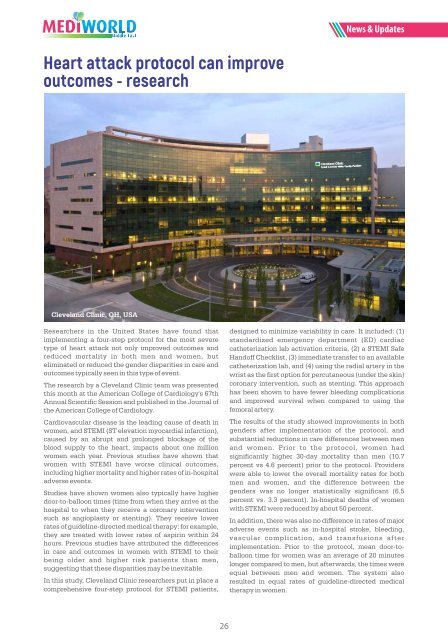Mediworld 07th MAR-APR Final Draft for Print REVISE COPY
You also want an ePaper? Increase the reach of your titles
YUMPU automatically turns print PDFs into web optimized ePapers that Google loves.
News & Updates<br />
Heart attack protocol can improve<br />
outcomes - research<br />
Cleveland Clinic, OH, USA<br />
Researchers in the United States have found that<br />
implementing a four-step protocol <strong>for</strong> the most severe<br />
type of heart attack not only improved outcomes and<br />
reduced mortality in both men and women, but<br />
eliminated or reduced the gender disparities in care and<br />
outcomes typically seen in this type of event.<br />
The research by a Cleveland Clinic team was presented<br />
this month at the American College of Cardiology's 67th<br />
Annual Scientific Session and published in the Journal of<br />
the American College of Cardiology.<br />
Cardiovascular disease is the leading cause of death in<br />
women, and STEMI (ST elevation myocardial infarction),<br />
caused by an abrupt and prolonged blockage of the<br />
blood supply to the heart, impacts about one million<br />
women each year. Previous studies have shown that<br />
women with STEMI have worse clinical outcomes,<br />
including higher mortality and higher rates of in-hospital<br />
adverse events.<br />
Studies have shown women also typically have higher<br />
door-to-balloon times (time from when they arrive at the<br />
hospital to when they receive a coronary intervention<br />
such as angioplasty or stenting). They receive lower<br />
rates of guideline-directed medical therapy: <strong>for</strong> example,<br />
they are treated with lower rates of aspirin within 24<br />
hours. Previous studies have attributed the differences<br />
in care and outcomes in women with STEMI to their<br />
being older and higher risk patients than men,<br />
suggesting that these disparities may be inevitable.<br />
In this study, Cleveland Clinic researchers put in place a<br />
comprehensive four-step protocol <strong>for</strong> STEMI patients,<br />
designed to minimize variability in care. It included: (1)<br />
standardized emergency department (ED) cardiac<br />
catheterization lab activation criteria, (2) a STEMI Safe<br />
Handoff Checklist, (3) immediate transfer to an available<br />
catheterization lab, and (4) using the radial artery in the<br />
wrist as the first option <strong>for</strong> percutaneous (under the skin)<br />
coronary intervention, such as stenting. This approach<br />
has been shown to have fewer bleeding complications<br />
and improved survival when compared to using the<br />
femoral artery.<br />
The results of the study showed improvements in both<br />
genders after implementation of the protocol, and<br />
substantial reductions in care differences between men<br />
and women. Prior to the protocol, women had<br />
significantly higher 30-day mortality than men (10.7<br />
percent vs 4.6 percent) prior to the protocol. Providers<br />
were able to lower the overall mortality rates <strong>for</strong> both<br />
men and women, and the difference between the<br />
genders was no longer statistically significant (6.5<br />
percent vs. 3.3 percent). In-hospital deaths of women<br />
with STEMI were reduced by about 50 percent.<br />
In addition, there was also no difference in rates of major<br />
adverse events such as in-hospital stroke, bleeding,<br />
vascular complication, and transfusions af ter<br />
implementation. Prior to the protocol, mean door-toballoon<br />
time <strong>for</strong> women was an average of 20 minutes<br />
longer compared to men, but afterwards, the times were<br />
equal between men and women. The system also<br />
resulted in equal rates of guideline-directed medical<br />
therapy in women.<br />
26

















